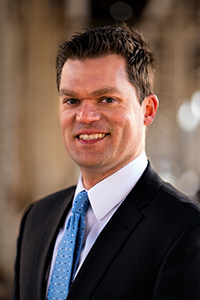The Time to Prepare Is Now
A roundtable discussion about the role actuaries can play to help mitigate climate change
March 2021Photo: iStock.com/DKosig



Scientists around the world agree that temperatures are rising faster than at many other times in history. Global warming is likely to persist, but we have the means to arrest some of the hazards that are wreaking havoc on our planet.
Steve Bowen, Emil Valdez, Ph.D., FSA, and Claudio Forner graciously agreed to answer questions developed by the contributing editor team responsible for this issue of The Actuary: Sara Goldberg, FSA, MAAA; Emily Puntenney, ASA, CERA, MAAA; Priya Rohatgi, ASA; and Tony Pistilli, FSA, CERA, MAAA. Read on for their insights on climate change, the role of the actuary, how climate change affects the insurance industry, the impact of COVID-19 and much more.
Climate change is often viewed as a longer-term threat. What material impact should the insurance industry (property and casualty, life and health) be concerned about in the near term?
Bowen: There is a perception that the impact of climate change has yet to emerge, but the reality is that the climate change footprint is already here and exists well beyond the physical hazards themselves (i.e., extreme weather events, “sunny day” coastal flooding, etc.). The insurance industry remains at the forefront of not only the increased disaster-related financial losses, but also recognizing that a more interconnected world means greater direct and indirect fiscal and humanitarian impacts on the clients they serve. Given the insurance industry’s close ties to governmental and other private-sector entities, the collaborative efforts around mitigation and other investment strategies will be critical as the world copes with increased risk and volatility.
Valdez: The risks attributable to climate change present an existential threat. I am hopeful that there are lessons we can learn from the COVID-19 crisis: The events leading to the crisis were slow, and the pandemic had a very low probability of occurrence; yet when it happened, we saw devastating consequences. There is a similarity to the looming threat of climate change, with events that may be happening in smaller increments leading to a major crisis.
We continue to observe record heat temperatures: 2020 became the second warmest year ever. The insurance industry has begun to feel the impact and threat of climate change, so we should be more concerned about the seriousness of the threat in the near term.
The cost of climate change to the insurance industry in the United States in 2020 was more than half of the total losses—the total damage was $95 billion, of which $67 billion were insured losses. The damage not covered by insurers must be sourced from elsewhere, such as the government. There is a ripple effect in that when the government pays for uncovered damages, the costs may come in the form of taxes. Everybody shares the costs to some extent.
Forner: It is not correct to view climate change as a longer-term threat, as this may imply the threat lies somewhere in the future. Climate change is a reality today: It is best described as a constant and increasing risk of climate-related disasters and, as the name suggests, gradual and exacerbating change in climatic variables (temperatures and precipitation primarily).
The material impacts of interest to the insurance industry are linked to actual covered risks and how premiums are calculated, and potential new areas for offering insurance services.
Actuaries often consider trade-offs (e.g., modest medical expenses for preventive care can lead to reduced expenses around complications and inpatient admissions). Some trade-offs are net-positive, while others are net-negative. How does climate science research evaluate trade-offs? What are the key offsetting benefits of combatting climate change, and to what extent have these been quantified?
Forner: Within the efforts to reduce emissions, science addresses the trade-offs at two different levels:
- From a global perspective, the estimations consider what the costs of inaction would be with the intention to justify the costs of action (e.g., reducing emissions by undertaking structural changes in the economy). There are several calculations, of which the most widely discussed (and criticized) include the Stern report, Organisation for Economic Co-operation and Development (OECD) and others. Such costs are calculated globally and into the future for different scenarios of global warming. The costs of inaction are based on long-term global climate models that provide information on change for climatic variables and increased risk of extreme weather events. Estimates are presented in terms of a reduction of expected global gross domestic product (GDP) based on reduced productivity, physical damage and devaluation, linked to sea level rise, for example.
- From a national or local perspective, the assessment of trade-offs depends on whether actions are to reduce emissions or adapt to the impacts of climate change. In the case of mitigation actions, where it is not straightforward to connect the reduction of emissions to reduced global impacts, trade-off studies generally are based on cost-benefit analysis, which contrasts the costs of the action of investments with its benefits beyond financial flows. These could include social factors, such as job opportunities and losses for a group, increased efficiency in resource use, modernization and cobenefits, such as reduced pollution and related health benefits, and others. To my knowledge, these are well understood, and proper costing methods are available—at least in the developed world. In the case of adaptation actions (e.g., building a barrier to prevent sea level rise), the information available is less certain.
Bowen: Several organizations have studied the cost benefit of retrofitting or strengthening building codes. The National Institute of Building Sciences showed that in the case of major perils, such as wildfire, flood, storm surge or hurricane wind, there is an estimated return of investment between 4:1 and 10:1. With populations continuing to grow in some of the most vulnerable regions for natural perils, it becomes more imperative to communicate these risks and the cost savings of investing upfront to better prepare a home or business. While there are varying levels of uncertainty around the expected influence of climate change for different perils, the overwhelming scientific consensus is the behavior of weather events will become more volatile and more intense. The time to prepare is now.
The COVID-19 pandemic exposed certain fragilities, our interconnectedness globally and linkages of risk; yet on the other hand, it provided relief on carbon emissions. What has COVID-19 taught us about the effort to address climate change?
Valdez: We need government mandates and a government agency such as the Environmental Protection Agency (EPA) to be a go-to agency to address and impose some of these regulations. Both transparency and accountability should be imposed. We need periodic communication of this crisis to the media and public.
As individuals, we need to take personal responsibility seriously during a pandemic or crisis. We can make a difference by reducing our own carbon or environmental footprints. The Deep Decarbonization Pathways Project (DDPP) provides systematic roadmaps to individuals, cities, communities, states and regions to help various economies promote goals for reaching a large reduction in greenhouse gas (GHG) emissions. Individuals can contribute to this goal by following a path to reduce their personal carbon footprint—there are now several mobile apps that may help you measure your own personal carbon footprint.
To reduce your environmental footprint is, therefore, a trade-off to changes in your everyday living. Examples of trade-offs to reduce your personal carbon footprint include:
- Reducing consumption of livestock while increasing consumption of organic fruits and vegetables
- Buying recycled clothes and other recycled products
- Using energy-efficient computers, appliances and other equipment
- Having an energy-efficient home
Finally, our recipes for making decisions and taking actions should be based on science and evidence from data. We should increase our personal understanding of the science of climate change; our government and private sector should assist to support climate science research.
Forner: Restrictions linked to the COVID-19 pandemic have had a direct and deep effect on economic activity and, hence, on emissions. According to some estimates, paired with a drop in global GDP of about 5 percent in 2020, global emissions could fall by 8 percent in the same year. According to the Intergovernmental Panel on Climate Change (IPCC), to reach the 1.5 C goal, emissions should fall 45 percent below 2010 in 2030 and reach net zero in 2050. An annual reduction of 8 percent in a single year is, without a doubt, a positive from a climate change perspective as, before the pandemic, emissions were rising instead of going down. For the 1.5 C goal to be met, a similar reduction would need to be sustained. However, the effect of COVID-19 on emissions is expected to be temporary as economic activity rebounds.
The COVID-19 pandemic has revealed human ingenuity and the ability to cooperate to address a large crisis. While not entirely harmonious, this has been the case with vaccine development, social distancing programs and others. The response to the pandemic has demonstrated that countries have the capacity to react to address global challenges and pursue common goals when prosperity depends on them.
Bowen: Perhaps the biggest takeaway from COVID-19 and its relation to climate change is that it highlighted the gaps and vulnerabilities around coping with multiple concurrent large-scale events. There have been notable challenges in being able to navigate relief and recovery, especially in developing nations that are dependent on international support. On the flip side, the pandemic did lead to a notable reduction in carbon dioxide and other emissions during 2020. While the reduction seen in 2020 is something that would need to be replicated for the foreseeable future to start stabilizing carbon dioxide concentrations in the atmosphere, it was an important data point for scientists to show the public how changes in human behavior can positively affect the environment.
What is the role of the actuarial community in addressing climate change? How have your partnerships with actuaries been fruitful? What do actuaries need to do to increase their fluency around climate change? Given your knowledge of the actuarial profession and skill set, how would you describe the profile of a climate actuary taking shape, both inside and outside of the insurance industry?
Bowen: The best advice I can provide to actuaries is to learn the nuances of the topic beyond climate data itself. There are many interconnected parts that contribute to climate change risk. Some topics include physical hazard, human behavior, implementation of building codes, infrastructure investment, financial stress tests (such as the Prudential Regulation Authority [PRA] in Europe) and so on. There are enormous challenges posed by climate change, and it is not an understatement that virtually every business sector can play an important role in how prepared we are for the impacts of tomorrow.
Valdez: As individuals, we all have a crucial role to play in helping to address the threat posed by climate change. Actuaries can assume a unique role of utilizing the multidisciplinary nature of their work, which is principally concerned with the science of measuring and managing risks. The profession should use its skills of not only being able to evaluate the financial or economic consequences of climate change, but also to provide meaningful advice as to the mitigation of the threat.
In terms of measurement, the actuarial profession already has commenced with the development of the Actuaries Climate Index (ACI), which is updated periodically and provides a measure of extreme weather-related changes in mainly the United States and Canada. This is a collaboration of four professional bodies: the American Academy of Actuaries (AAA), Casualty Actuarial Society (CAS), Society of Actuaries (SOA) and the Canadian Institute of Actuaries (CIA).
Forner: The assessment of climate risk has been there for quite a while, but interest in the subject from central governments and the private sector has been increasing. The International Monetary Fund (IMF) now calls climate change macro-critical, which implies that central banks are making great efforts to understand and value climate risk and the implications for macro-economic variables. The same goes for finance ministers, who are interested in understanding the risks of climate change for the financial system. On the private-sector side, the same is the case for investors and companies worried about profitability and exposure (as it relates to so-called transition risk).
Actuaries are well positioned to work with climate modelers to improve their methods and tools in a way that they can produce data and information that can be used by these actors. They also will play a role in measuring risk and putting a dollar value on it.
How have the scientific and global policy communities’ understanding of climate change evolved in the last 10 years? What are the key outstanding questions actuaries could answer?
Forner: Basic science of climate change has been relatively settled for a long time, and the processes and variables behind climate change are understood well enough. As always with science, there will forever be room for improvement of what is already known until that elusive and ideal point of fully understanding the atmosphere and its dynamics is reached. Most of the key scientific questions that remain open relate to what we do with that information.
There is the issue of better understanding, measuring and anticipating threats and impacts of climate change. Models have become much better, but they are still subject to great uncertainty. Also, there is still a large gap between global and local analyses, which is a problem when it comes to supporting central and subnational governments and private-sector actors. Alternative and proxy methods could be used to bridge this important gap.
Finally, there also is the need to better understand the response (e.g., actions to reduce emissions) and the socioeconomic, fiscal and financial consequences of policies and other actions to decarbonize the economy.
Bowen: Research continues to move our understanding of climate change forward. In the past 10 years alone, we’ve seen a narrowing of uncertainty around what the impacts of climate change may look like. This clearer picture has allowed a significant step forward by governmental bodies, insurers, asset managers, real estate and other financial institutions to start implementing mitigation strategies and stress tests to ensure solvency.
Perhaps the “holy grail” topic that exists is around attribution and the quantification of climate change on a per-event or per-peril basis. We know weather events are always going to occur, but determining the percentage enhancement by climate change compared to a universally accepted baseline will be useful in planning purposes.
Valdez: For actuaries, now is the right time to take proactive actions to contribute to combative efforts of the government. Actuaries, through their various professional bodies, can extend their expertise in helping measure the depth of the problem we face on climate change through knowing loss exposure, and they can provide insurance programs with advice and actions on mitigating the financial consequences posed by climate change. Actuaries should also recognize that insurance mechanisms may not always be the most effective measure to mitigate threats from climate change; we as a profession can learn from other experts—for example, the government and climate science researchers and organizations—to better understand obstacles.
Statements of fact and opinions expressed herein are those of the individual authors and are not necessarily those of the Society of Actuaries or the respective authors’ employers.
Copyright © 2021 by the Society of Actuaries, Chicago, Illinois.

